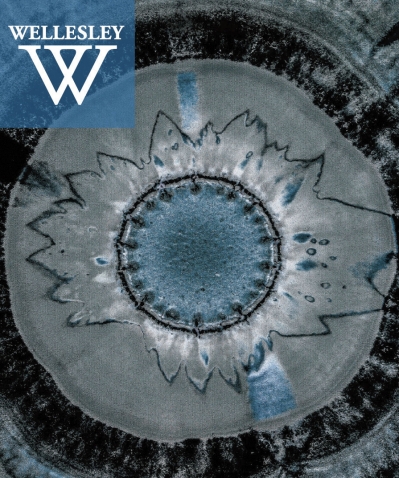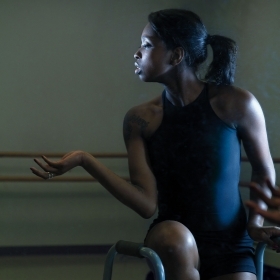Book Arts, Way Back
I was delighted to read in the latest College magazine that the Book Arts Lab is still there and doing well (“Book Learning,” summer ’19). I believe that my classmate Edith Kynor Sprouse and I were the first to enjoy that lab, before it had a name.
We graduated from Wellesley in the class of 1945 and spent many blissful hours in 1944–45 in the basement of the library with Hannah French. Those were awful years of war, and our friends were dying in Europe and the Pacific. We escaped the stress of the news, and our academic classes, by setting type, wetting paper, spreading ink, and holding our breath as we closed the press, hoping it would turn out well.
Today it would be called “occupational therapy,” I suppose. We wrote poems and printed two copies of a book of these verses with the title, The Muses Weep. My copy is precious to me, and I think it has value, certainly not for its literary quality, but as part of Wellesley’s history, as the first book produced at the lab.
Eleanor Herz Swent ’45, Palo Alto, Calif.
Book Memories
I can’t begin to tell you how much I enjoyed the feature article on the Book Arts Lab (“Book Learning,” summer ’19). In this era of instant, ephemeral tech contact, traditional, hands-on skills such as are taught here are priceless.
It made me remember my favorite Summer Symposium program for alumnae on “The Art and History of the Book,” held in 1997. My classmate, Betsy Palmer Eldridge ’59, whom you cited in the article, was there to demonstrate her considerable skills in bookbinding. We were taught, among other topics, that fonts were political in their invention, especially the transition from the edgy German Gothic to the elegant and easy to read Roman fonts such as Bembo, Garamond, and Bodoni.
Thank you for these memories and also for Lisa Scanlon Mogolov’s fine article.
Nina Budde Scott ’59, Amherst, Mass.
The Book Revival
The Wellesley mag finally arrived on my doorstep, and I immediately sat down to read the Book Arts Lab article (“Book Learning,” summer ’19). I enjoyed it tremendously, and thought the pictures added a great deal to the story. Congratulations! We are all rather fascinated at the amount of interest that seems to be showing up about books and their physical aspects, just when they are supposed to be a dying art. We can’t quite guess where this interest is coming from. It seems out of the thin air, but the internet seems to be responsible for a lot of it! If there is something I can do to help it, I hope someone will speak up and let me know.
Betsy Palmer Eldridge ’59, independent book and paper conservator, Toronto
Making Inclusion Real
Regarding “Thinking About Difference Differently” (spring ’19):
Best piece I’ve read on making diversity, equity & inclusion real. Kudos to @Wellesley@DrPaulaJohnson for your serious and substantive efforts for “inclusive excellence” in academics and student life. … Proud to be an alum.
@sarahtlucas (Sarah Lucas ’92, San Francisco) via Twitter
Another Ambassador
Let me add my name to the list of Wellesley alumnae who have been ambassadors: I served as American ambassador to Senegal in 1991–92 (“The Art (and Life) of Diplomacy,” spring ’19). My previous posts included New Delhi, Warsaw, Rome, and Palermo as well as several postings in Washington at the Department of State and a year as a visiting fellow at Brown University.
A historical footnote: When I joined the foreign service in 1965, at the beginning of almost 30 years as a career diplomat, there was no particular effort to recruit female officers, and, indeed, I was the only woman foreign service officer in my entering class of 26. At that time, the Department of State would not permit married officers to serve together at overseas postings, so I faced the choice of resigning or accepting separate postings when I married a fellow U.S. diplomat. But times were changing, and the State Department was changing with them. In 1971, at our embassy in Warsaw, my husband, Jock, and I became the first so-called tandem couple in the service. After that, a number of women who had resigned in the past were able to resume their careers, and today there are many tandem couples in our diplomatic service.
Katherine Horberg Shirley ’64, Gladwyne, Pa.
Diversity of All Kinds?
The spring ’19 issue of Wellesley contained four references to diversity on campus, none of which addressed diversity of ideas. In the first, the magazine’s editor states “Highlighting diversity and promoting inclusivity are critical to us” (“From the Editor”). The magazine indeed does a good job of highlighting intellectual diversity. But does diversity at the College itself include diversity of ideas? Are nonprogressive political viewpoints welcome on campus? Based on a “Notable and Quotable” reference in the Wall Street Journal on 4/14/17, the Wellesley student newspaper is decidedly not open to different opinions. The title of the article: “Shut Up, Wellesley Students Explained.”
The second reference to diversity was in the screed by Maggie O’Grady ’04 about the Republican Party (“Letters to the Editor”). Apparently, diversity of opinion is not part of her Wellesley, either.
The third reference was the article “Civility in the Politics Classroom” (Window on Wellesley). While I celebrate the call for diversity of opinion in Ms. Schlozman’s class, I wonder how well supported students are if they do not hoe the progressive row. Ms. Schlozman’s own political views are very clear, given her references to wealth in the political discourse and her support of campaign finance reform and early voter registration. Does anyone in class dare to challenge the overwhelming Democratic peer pressure?
Lastly, nowhere in the article “Thinking About Difference Differently” was the issue of how students with different values and ideas are treated raised. Based on the above-referenced Wall Street Journal article, my guess is they are not treated well.
In sum, what is Wellesley doing to promote diversity of ideas on campus? How is it enabling students to confront differing opinions with argument and thought rather than emotion? How is it encouraging questioning any current consensus of opinion?
May the debate begin—assuming, of course, that Wellesley supports diversity in all its aspects.
Susan Winokur ’74, Seattle
Don’t Speak for Me
I am appalled by the open hatefulness and closed-mindedness of the writer Maggie O’Grady ’04 in her letter “The Republican Party” published in the spring ’19 issue of the Wellesley magazine. Her absolute condemnation of differing views and political affiliations is a condemnation of the College itself and the freedom of thought for which it has always stood. For me, coming from the segregationist South, the College life and classes (I was a political science major) opened a world far beyond the confines of our beautiful campus. Today, I enjoy the rich culture of a small Caribbean island as a teacher of tourism education in the public schools, a working minority member of a society with no “labels.” O’Grady states: “Wellesley taught us all better than that.” She does not speak for me.
Deborah Kopp Lellouch ’61, Charlestown, Saint Kitts and Nevis
More Disappointment
I had almost completely stopped reading the mag altogether out of disgust over some of the presumptuous left-wing rhetoric laced within the content. Straight from mailbox to recycle. But I did follow the Maggie O’Grady ’04 incident.
I would like simply to add my voice to the disappointment and outrage, already expressed by some other alums, over the vitriolic intolerance to views at odds with Ms. O’Grady’s.
I have feared for a while that even Wellesley has become a political indoctrination program, that it is no longer a place of distanced reflection on the course of human experience.
Carol I. Palmer ’78, Durham, N.C.







